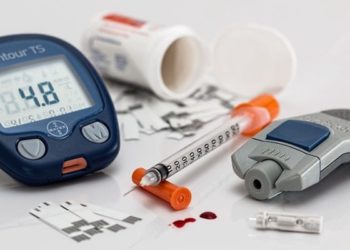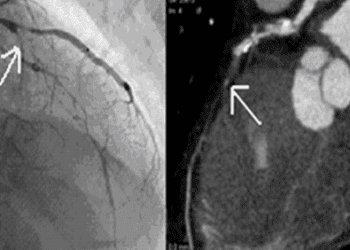The DIGAMI trial: Insulin-glucose infusion in diabetics with acute MI [Classics Series]
Image: PD
1. In diabetic patients with acute myocardial infarction, insulin-glucose infusion with subsequent long-term insulin treatment reduces mortality at 1 year.
Original Date of Publication: July 1995
Study Rundown: At the time of the DIGAMI study (1995), diabetic patients were shown to have higher mortality rates post-myocardial infarction (MI) than non-diabetic patients. This difference remained despite the introduction of new therapeutic measures, such as beta-blockers. Increased fatty acid metabolism in diabetes is thought to decrease the anaerobic process of glycolysis that is important for the survival of ischemic tissue. The DIGAMI study showed that, in diabetic patients already receiving beta-blockers and thrombolytic treatment, metabolic control via an insulin-glucose infusion and long-term insulin therapy further decreased post-MI mortality after 1 year.
It is unclear from the study results whether the immediate insulin-glucose infusion or the subsequent multidose insulin therapy is most responsible for the decrease in post-MI mortality. The lack of free fatty acid measurements also limits the study from clarifying the mechanism of benefit from insulin treatment post-MI. Only half of the 1,240 eligible patients were randomized for the study, resulting in a relatively small sample size, wide confidence intervals, and potential bias due to the exclusion of patients unwilling to undergo aggressive insulin therapy. Lastly, >80% of patients in the study were previously non-insulin dependent, suggesting that the benefits of insulin treatment may be limited to patients with the least baseline disease.
In summary, the DIGAMI study demonstrated a role for insulin therapy in diabetic patients who experience acute MI.
Please click here to read study in JACC
In-Depth [randomized, controlled study]: Originally published in JACC in 1995, the DIGAMI trial was a randomized trial involving coronary care units in 19 Swedish hospitals. Inclusion criteria included suspected acute MI within the preceding 24 hours in a patient with previously diagnosed diabetes mellitus (DM), or in a patient with a blood glucose level > 11 mmol/liter without a previous DM diagnosis. All patients received thrombolytic treatment (i.e., streptokinase) and beta-blockade (i.e., metoprolol), and were randomized to additionally receive an insulin-glucose infusion with follow-up multidose insulin therapy, or not. At 1 year, the mortality rate in the insulin group was significantly lower than that of the control group (RRR 29%, P=0.027).
By Evan Chen and Andrew Cheung, M.D.
© 2013 2minutemedicine.com. All rights reserved. No works may be reproduced without expressed written consent from 2minutemedicine.com. Disclaimer: We present factual information directly from peer reviewed medical journals. No post should be construed as medical advice and is not intended as such by the authors, editors, staff or by 2minutemedicine.com. PLEASE SEE A HEALTHCARE PROVIDER IN YOUR AREA IF YOU SEEK MEDICAL ADVICE OF ANY SORT.






